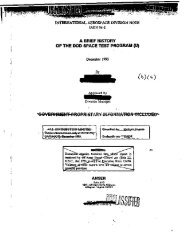LUNAR EXPEDITION PLAN
LUNAR EXPEDITION PLAN
LUNAR EXPEDITION PLAN
You also want an ePaper? Increase the reach of your titles
YUMPU automatically turns print PDFs into web optimized ePapers that Google loves.
will be attainable. Also, no difficulties are foreseen In<br />
maintaining suspension of the rotating member In an acceleration<br />
field of 1? g's with 30 g's being possible. Developaent<br />
of a small inertial platform utilizing electrically suspended<br />
gyros will be required for the lunar mission.<br />
4.2-5-3 STAR 5RACKKR<br />
In order to Increase the reliability- and the accuracy<br />
of the inertial platform, a compact star tractor for use vitb<br />
the platform during the outbound and Inbound mid-course phases<br />
of the lunar flight Is desired. Also, the star tracker should<br />
be capable of operating in a lunar environment so that It can<br />
be used for stellar alignment during the lunar launch portion<br />
of the mission. The accuracy of present solid state star trackers<br />
is approximately 10 seconds of arc and their wight Is approximately<br />
15 pounds. However, these trackers are' untested In a<br />
space environment and must be developed for the lunar mission<br />
and for use with the small inertial platform. In particular,<br />
tile star tracker must be capable of furnishing accurate stellar<br />
alignment Information to the inertial platform during the lunar<br />
ascent portion of the mission- If It Is possible to develop a<br />
controllable thrust engine In time to meet the launch schedule,<br />
the boost and Injection guidance problem for the lunar ascent<br />
will be simplified as it will be possible to time-control a<br />
predetermined velocity path, abit development could possibly<br />
reduce the accuracy requirement of the star tracker.<br />
4.2.5-4 LONG BASHJKB RADIO MAVIGATICfr,<br />
Since manned as veil as unmanned flights are planned fox<br />
the lunar mission, it Is necessary to have a navigation system<br />
to back-up the inertial system and to Increase the over-all<br />
accuracy of the guidance and control techniques. Long baseline<br />
radio/radar tracking and guidance techniques offer great possibilities<br />
for tracking and guiding vehicles in cislunar space.<br />
ftresent studies show that there are a number of problems yet<br />
to be solved to give the long baseline radio navigation technique<br />
the desired accuracy. Among these problems are l) the accuracy<br />
with which coordinates can be determined for each tracking<br />
station, 2) the accuracy vith which corrections can be made for<br />
tropbspberic and ionospheric propagation effects on the^rstea_<br />
measuremejits^_and_3D_t^-aco4ira^^ can be<br />
synenr^Szeo^at^the several stations. Reasonable extensions<br />
of the state-of-the-art should be able to overcome these<br />
problems however, and it is felt that the development of a<br />
long baseline radio navigation system will be necessary for<br />
the lunar mission.<br />
k.21 v




